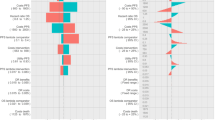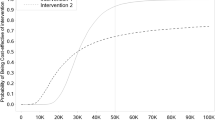Abstract
A comprehensive cost-effectiveness decision model will often go beyond a one-to-one comparison and will include a number of competing alternatives. Only a simultaneous assessment of all relevant treatment alternatives avoids comparing average cost-effectiveness ratios and allows a truly incremental analysis. Two issues arise if the analysis is probabilistic, namely, the occurrence of output correlations and difficulty in presenting the results. I have examined the role of output correlations using a screening model with eight alternatives and have shown that specifically cost–cost and quality-adjusted life years (QALY)–QALY correlations between alternatives have a major impact on decision uncertainty, as measured by the probability of the cost-effectiveness and expected value of perfect information. In particular, the latter strongly depends on between-alternative output correlations. This analysis shows that both the expected value of perfect information plots and acceptability curves/frontiers are sensitive to output correlations and thus appropriate for presentation of multiple alternatives. To avoid confusing statistical significance and economic importance I propose that acceptability curves be augmented by incremental net-benefit density plots at a given willingness to pay threshold.


Similar content being viewed by others
References
Claxton, K.: The irrelevance of inference: a decision-making approach to the stochastic evaluation of health care technologies. J. Health. Econ. 18(3), 341–364 (1999)
Briggs AH, Gray AM: Handling uncertainty when performing economic evaluation of healthcare interventions. Health Technol Assess. 3(2) (1999)
Glick, H.A.: Sample size and power for cost-effectiveness analysis (part 1). Pharmacoeconomics. effectiveness analysis (part 1). Pharmacoeconomics. 29, 189–198 (2011)
National Institute for Health and Clinical Excellence: Guide to the methods of technology appraisal, June 2008. Available at: http://www.nice.org.uk/media/B52/A7/TAMethodsGuideUpdatedJune2008.pdf. Accessed 19, Sept 2012
Cooper, N.J., Peters, J., Lai, M.C.W., et al.: How valuable are multiple treatment comparison methods in evidence-based health-care evaluation? Value Health 14, 371–380 (2011)
Saramago, P., Manca, A., Sutton, A.J.: Deriving input parameters for cost-effectiveness modeling: taxonomy of data types and approaches to their statistical synthesis. Value Health 15, 639–649 (2012)
Jakubczyk, M., Kamiński, B.: Cost-effectiveness acceptability curves—caveats quantified. Health Econ. 19, 955–963 (2010)
Rojnik, K., Naveršnik, K., Mateović-Rojnik, T., et al.: Probabilistic cost-effectiveness modeling of different breast cancer screening policies in Slovenia. Value Health 11(2), 139–148 (2008)
Barton, P.: What happens to value of information measures as the number of decision options increases? Health Econ. 20(7), 853–863 (2010)
Koffijberg, H., de Wit, G.A., Feenstra, T.L.: Communicating uncertainty in economic evaluations: verifying optimal strategies. Med. Decis. Making 32, 477 (2012)
Sadatsafavi, M., Najafzadeh, M., Marra, C.: Acceptability curves could be misleading when correlated strategies are compared. Med. Decis. Making 28, 306–307 (2008)
Iman, R.L., Conover, W.J.: A distribution free approach to inducing rank correlation among input variables. Commun. Stat. Simulat. B11(3), 311–334 (1982)
Barton, G.R., Briggs, A.H., Fenwick, E.: Optimal cost-effectiveness decisions: the role of the cost-effectiveness acceptability curve (CEAC), the cost-effectiveness acceptability frontier (CEAF), and the expected value of perfection information (EVPI). Value Health 11(5), 886–897 (2008)
Naveršnik, K., Rojnik, K.: Handling input correlations in pharmacoeconomic models. Value Health 15, 540–549 (2012)
Redelmeier, D.A., Shafir, E.: Medical decision making in situations that offer multiple alternatives. JAMA 273(4), 302–305 (1996)
Stinnett, A.A., Mullahy, J.: Net health benefits: a new framework for the analysis of uncertainty in cost-effectiveness analysis. Med. Decis. Making. 18[Suppl 2] S68–S80 (1998)
Fenwick, E., Claxton, K., Schulper, M.: Representing uncertainty: the role of cost-effectiveness acceptability curves. Health Econ. 10, 779–787 (2001)
Bala, M.V., Zarkin, G.A., Mauskopf, J.: Presenting results of probabilistic sensitivity analysis: the incremental benefit curve. Health Econ. 17, 435–440 (2008)
Leshno, M., Levy, H.: Stochastic dominance and medical decision making. Health Care Manag. Sci. 7, 207–215 (2004)
Koerkamp, B.G., Hunink, M.G.M., Stijnen, T., et al.: Limitations of acceptability curves for presenting uncertainty in cost-effectiveness analysis. Med. Decis. Making 27(2), 101–111 (2007)
Fenwick, E., Briggs, A.H.: Cost-effectiveness acceptability curves in the dock: case not proven? Med. Decis. Making 27(2), 93–95 (2007)
British Psychological Society: Schizophrenia: core interventions in the treatment and management of schizophrenia in primary and secondary care (update). National Collaborating Centre for Mental Health (UK): Leicester (UK). (2009)
Zivin, J.G.: Cost-effectiveness analysis with risk aversion. Health Econ. 10, 499–508 (2001)
Author information
Authors and Affiliations
Corresponding author
Rights and permissions
About this article
Cite this article
Naveršnik, K. Output correlations in probabilistic models with multiple alternatives. Eur J Health Econ 16, 133–139 (2015). https://doi.org/10.1007/s10198-013-0558-0
Received:
Accepted:
Published:
Issue Date:
DOI: https://doi.org/10.1007/s10198-013-0558-0




